Immunodeficiency in the absence of high viral load in pig-tailed macaques infected with Simian immunodeficiency virus SIVsun or SIVlhoest
- PMID: 16254339
- PMCID: PMC1280237
- DOI: 10.1128/JVI.79.22.14044-14056.2005
Immunodeficiency in the absence of high viral load in pig-tailed macaques infected with Simian immunodeficiency virus SIVsun or SIVlhoest
Abstract
Simian immunodeficiency virus (SIV) is known to result in an asymptomatic infection of its natural African monkey host. However, some SIV strains are capable of inducing AIDS-like symptoms and death upon experimental infection of Asian macaques. To further investigate the virulence of natural SIV isolates from African monkeys, pig-tailed (PT) macaques were inoculated intravenously with either of two recently discovered novel lentiviruses, SIVlhoest and SIVsun. Both viruses were apparently apathogenic in their natural hosts but caused immunodeficiency in PT macaques. Infection was characterized by a progressive loss of CD4(+) lymphocytes in the peripheral blood and lymph nodes, generalized lymphoid depletion, a wasting syndrome, and opportunistic infections, such as Mycobacterium avium or Pneumocystis carinii infections. However, unlike SIVsm/mac infection of macaques, SIVlhoest and SIVsun infections in PT macaques were not accompanied by high viral loads during the chronic disease stage. In addition, no significant correlation between the viral load at set point (12 weeks postinfection) and survival could be found. Five out of eight SIVlhoest-infected and three out of four SIVsun-infected macaques succumbed to AIDS during the first 5 years of infection. Thus, the survival of SIVsun- and SIVlhoest-infected animals was significantly longer than that of SIVagm- or SIVsm-infected macaques. All PT macaques maintained strong SIV antibody responses despite progression to SIV-induced AIDS. The development of immunodeficiency in the face of low viremia suggests that SIVlhoest and SIVsun infections of macaques may model unique aspects of the pathogenesis of human immunodeficiency virus infection in humans.
Figures

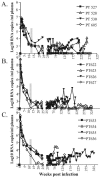


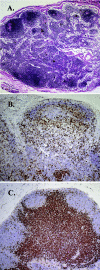
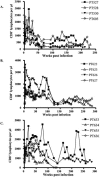
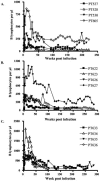
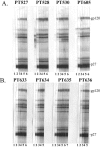
References
-
- Apetrei, C., D. L. Robertson, and P. A. Marx. 2004. The history of SIVs and AIDS: epidemiology, phylogeny and biology of isolates from naturally SIV infected non-human primates (NHP) in Africa. Front. Biosci. 9:225-254. - PubMed
-
- Bailes, E., F. Gao, F. Bibollet-Ruche, V. Courgnaud, M. Peeters, P. A. Marx, B. H. Hahn, and P. M. Sharp. 2003. Hybrid origin of SIV in chimpanzees. Science 300:1713. - PubMed
-
- Baskin, G. B., M. Murphey-Corb, E. A. Watson, and L. N. Martin. 1988. Necropsy findings in rhesus monkeys experimentally infected with cultured simian immunodeficiency virus (SIV)/delta. Vet. Pathol. 25:456-467. - PubMed
Publication types
MeSH terms
Substances
LinkOut - more resources
Full Text Sources
Research Materials

